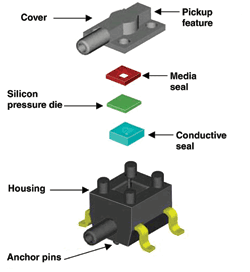Taking fluid pressures in medical environments
Pressure sensors that are compatible with liquid media often simplify design and reduce costs in medical systems
BY A.J. SMITH
Director of Product Marketing
Honeywell Sensing and Control
www.honeywell.com
Some OEM medical equipment demands pressure sensors for use in condensing humidity or for fluid-sensing applications. Liquid-media-compatible pressure sensors can often reduce design complexity and costs associated with protecting the sensor from fluids.
Selecting the best pressure sensor in these types of applications can be a daunting task. Medical OEMs need to select a sensor with the right mix of features, reliability, and cost. A key challenge for medical device designers is ensuring that the fluids or condensing humidity do not touch the sensor. This makes the designer’s job a little tougher.
Traditional approach
Traditionally, designers would select stainless-steel or other media-isolated pressure transducers for applications requiring liquid-media compatibility or having high-pressure requirements. Board-mounted silicon pressure sensors would be relegated to applications involving dry gases below 150 psi.
Thus, a gap existed for applications that only required pressures below 150 psi, but still required liquid-media compatibility. Such applications include gas/liquid chromatography instruments and blood analyzers, as well as other analytical lab equipment where accurate pressure measurement of reagents, samples, and flushing fluids is important.
Without a liquid-media-compatible sensor, a designer would have to add a bypass or a filter, or design fluid pathways specifically to prevent fluid contact with the pressure sensor. Not only does this often add time and complexity to the design, but it can also remove the sensor from the optimal point of measurement, compromising the performance of the overall system.
New options
Today, pressure sensors that can be board mounted are readily available to meet the requirements of low-pressure liquid-media applications. These sensors can simplify designs by eliminating the need for additional components or features to protect the board-mounted sensor from liquids or humidity.

Fig. 1: Pressure sensors that are compatible with liquid media are constructed to provide isolation of critical circuitry from the media while still allowing direct pressure readings.
Honeywell Sensing and Control, for example, now offers a broad range of board-mountable pressure sensors with liquid-media compatibility. Both the TruStability and 20PC series pressure sensors offer liquid-media compatibility with a wide range of characteristics, such as pressure ranges, package styles, and digital or analog outputs.
Design checklist
Even in applications where the sensor is not intended to get wet, such as diagnostics equipment, designers still need to consider worst-case scenarios. There could be a case where there is over-pressurization and the fluid moves up a tube further than expected and reaches the pressure sensor. In this case, the designer needs to create a system that protects the sensor from the liquid, or select a solution that can withstand the fluid, eliminating the need to add protection components.
Designers should use a simple design checklist to ensure that the pressure sensor meets the application’s requirements. This checklist includes:
• Compatible liquid media
• Pressure type and range
• Accuracy
• Mounting type
• Output (analog or digital)
• Supply voltage
The list can be extended with items specific to a particular application, but by obtaining the basic information above, a designer will be able to quickly narrow her or his selection to the best possible candidates. ■
Advertisement
Learn more about Honeywell Sensing and Productivity Solutions





